Affiliate links on Android Authority may earn us a commission. Learn more.
HSPA+ vs LTE: Which one is better?
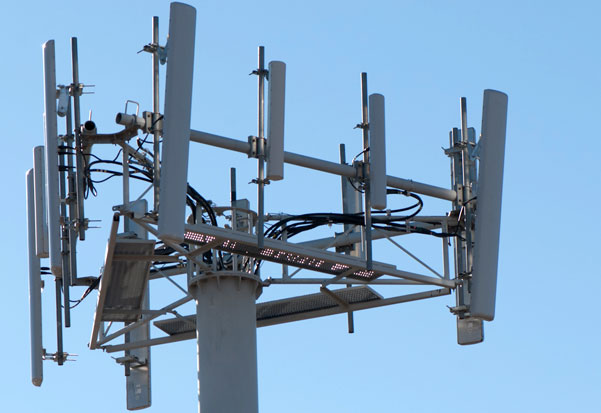
We have all marveled at the revolution in mobile communications technology. The 1980’s saw the introduction of the “brick” style wireless mobile phone accessible to a privileged few. Since then, we have seen a lot of shifting trends in designs and capabilities, but an exponential increase in availability and popularity. We now live in a world boasting over 6 billion mobile phone users, with most high-end devices mimicking the capabilities of a computer, featuring dual-core or even quad-core processing capability.

I still recall a time when the primary purpose of a mobile phone was voice communication. Now, with smartphones bursting onto the scene in ever growing numbers, the mobile landscape is changing rapidly. With devices now featuring messaging, social networking connectivity, email and browsing capabilities, and the ability to stream or download high-quality music and videos, making and receiving calls has almost become a secondary feature.
Of course, none of this would be possible without an equally impressive evolution in mobile networking technology. From first generation communication networks to the current 4G craze, these advances have made it incredibly easy for any user to always be connected. Today we will compare the latest networking technologies, namely HSPA+ and LTE, and take a look at what the future holds.
History
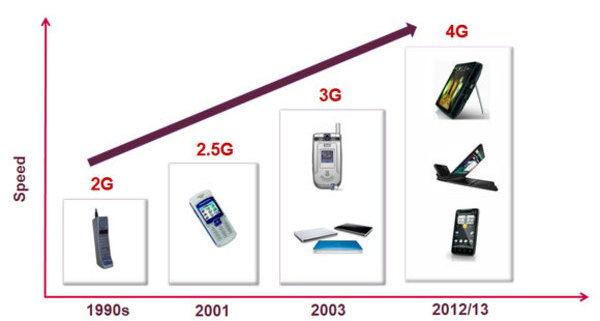
First generation mobile networks were basic analog systems designed purely for voice calls. Mobile devices and call rates were very expensive and therefore not available to everybody. The early nineties saw the introduction of the first digital cellular networks. 2G brought with it improved sound quality and a higher capacity, allowing for data services, albeit at very low speeds up to 14.4 kbps. Further advances in this technology introduced GPRS and EDGE features with quicker data speeds between 40kpbs to 100kbps.
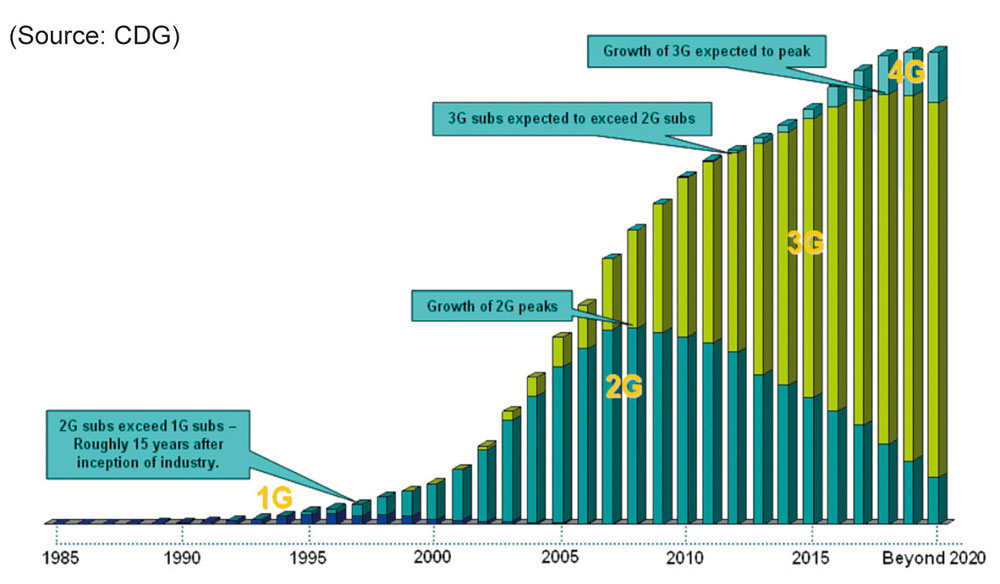
This was followed by the 3G revolution. Apart from wide-area voice telephony, it introduced high-speed internet access, far improved audio and video streaming capabilities, support for video calls and conferences, and internet TV. With effective speeds ranging from 128kbps to 384kbps, the advent of 3G completely changed the way people use their mobile phones.
The effective entry of the tablet and increasing dependency on handheld mobile devices led to demand for even faster speeds and connectivity options, leading to a new standard, HSPA+, followed by 4G LTE.
What is HSPA+ and LTE?
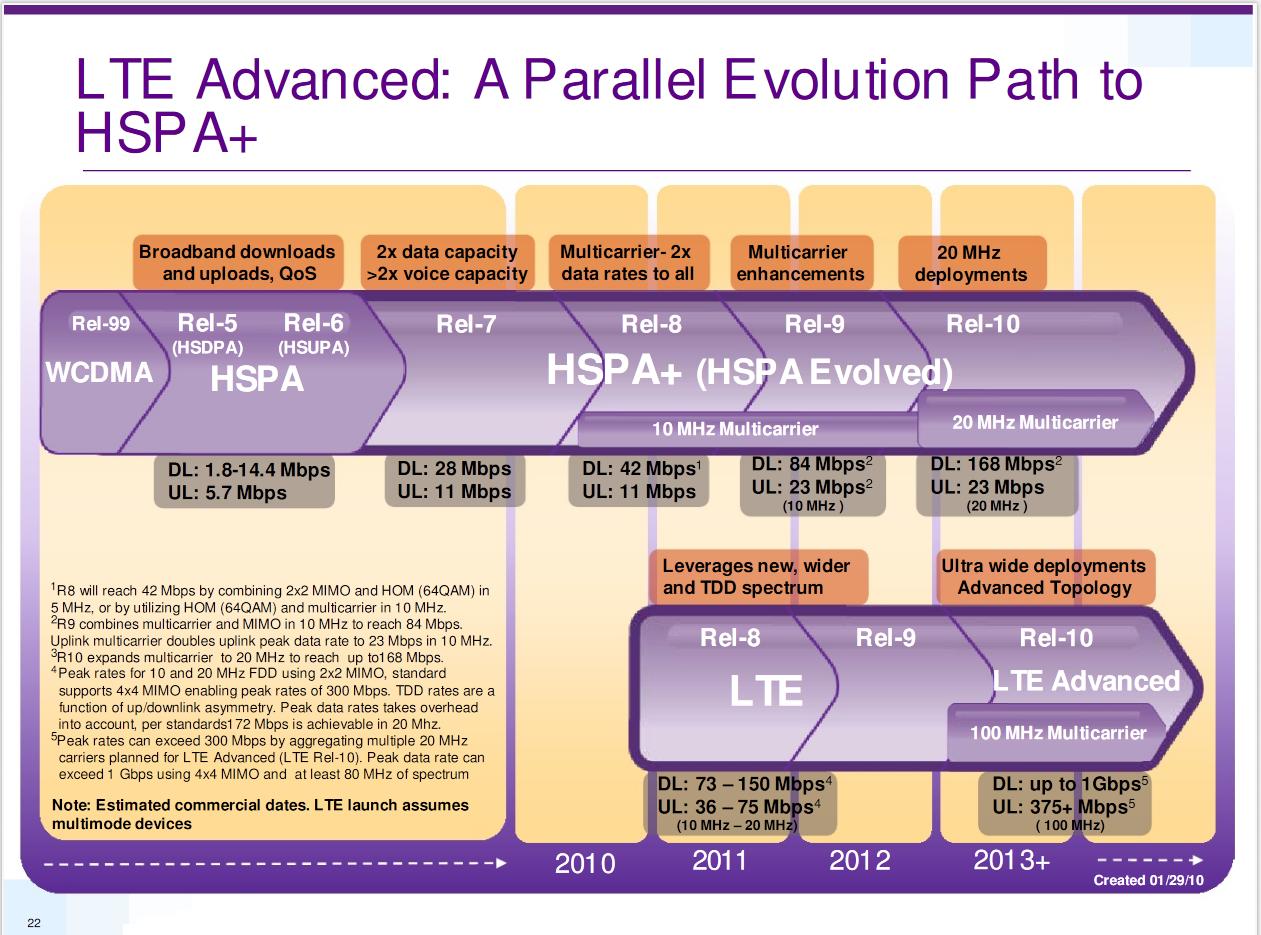
HSPA+
HSPA+ or Evolved High Speed Packet Access, is a souped-up version of HSUPA and HSDPA 3G standards with speeds comparable to the newer LTE networks. Theoretical speeds are said to feature download speeds up to 168Mbps and uplink of 22Mbps. These are of course theoretical speeds, with the actual speed available to users being much lower. While most HSPA+ networks around the world boast a theoretical 21Mbps(download) speed, T-Mobile(USA) and Deutsche Telekom(Germany) feature 42Mbps networks. A hotly debated issue is the 4G tag offered by cellular network companies to advertise their HSPA+ networks(T-mobile and AT&T), while most accept that it should be considered, at most, a 3.75G network.
LTE
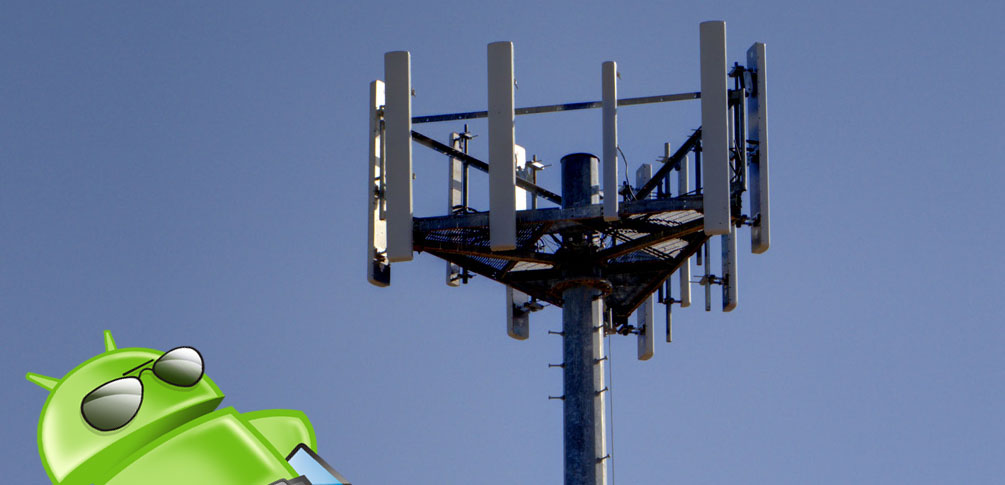
On the other hand, LTE, or Long Term Evolution, is considered a “true” 4G network. Theoretical speeds boast downlink speeds of 300Mbps and uploads of 75Mbps. LTE, which is an IP-based system, is a complete redesign and simplication of 3G network architecture resulting in a marked reduction in transfer latency. Because of this, LTE is not compatible with 2G and 3G networks and thus, functions on an entirely different wireless spectrum. Unfortunately, this means that erecting an LTE network requires it to be built from the ground up. This is one of the main factors behind the delayed launch of complete 4G LTE networks.
Bottom Line
HSPA+ is the tip of the mountain with 3G technology, and LTE is simply the foundation for a new mountain. LTE, also known as 4G, is the most advanced telecommunications technology currently available, and is one that defines a clear path toward future developments, making it the most attractive choice for carriers these days.
Speed Comparison
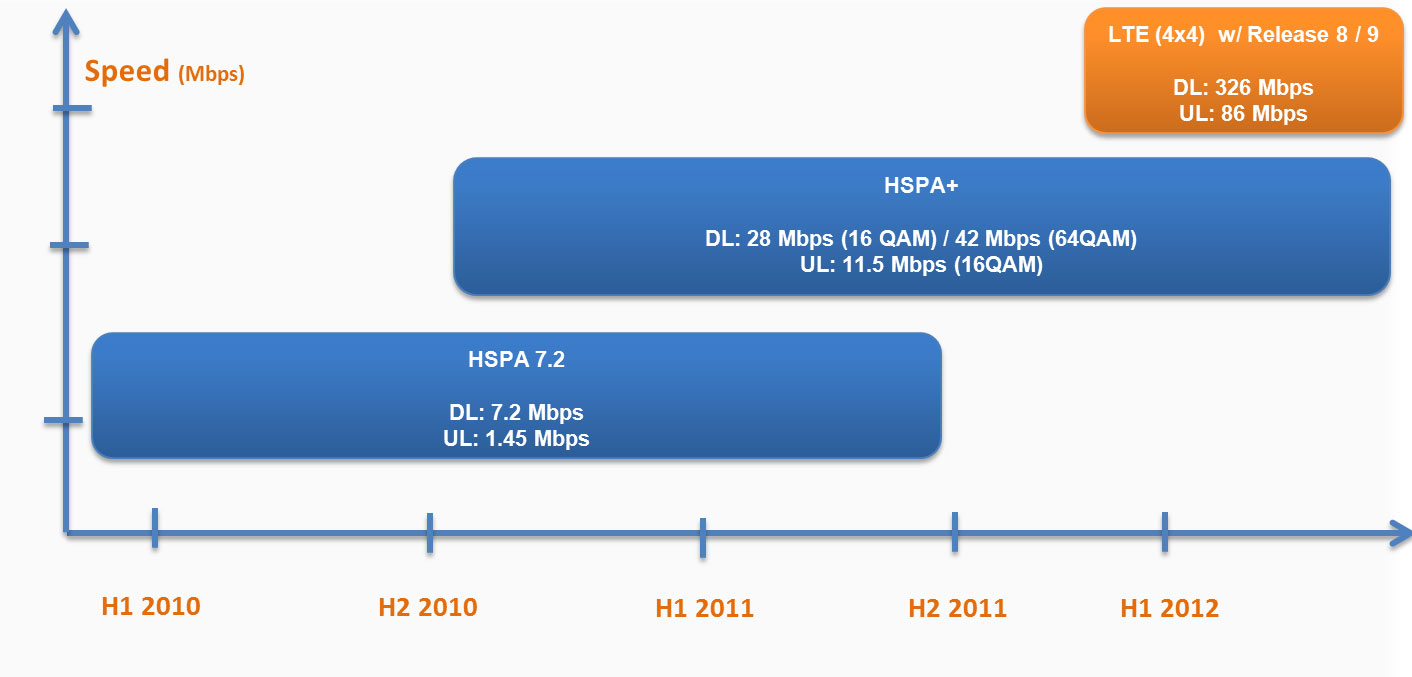
The biggest question consumers have is whether the additional cost of buying an LTE-enabled device and the higher data charges are worth it, compared to the “slower” but relatively cheaper 3G and HSPA+ networks. Let’s take a look.
Under consideration are speed comparisons based on the recently conducted wireless speed tests by PCWorld, of the major network carriers in the US (AT&T, T-Mobile, Verizon, and Sprint). For our purposes, we are going to compare the LTE-based AT&T and Verizon 4G networks, against the 42 Mbps HSPA+ based T-Mobile “4G” network. While Sprint and T-Mobile both aim towards launching their LTE networks soon, as of now, they are based on Wi-Max technology and HSPA+ respectively.

PCWorld, along with their testing partners Novarum, conducted the tests using Ookla’s speed test app in 13 cities across the US including San Francisco, Los Angeles, San Jose, Seattle, Las Vegas, Denver, Dallas, Chicago, New Orleans, New York, Washington D.C., and Boston.
There are a few key points to note from the chart above:
- T-Mobile’s HSPA+42 network performs admirably against, what is supposed to be, far superior LTE networks. The high speeds offered by this network should be more than enough for most users.
- LTE is fast! While HSPA+ is definitely good enough, the LTE networks(in their current state) are 20-30% faster. A big plus for all the speed demons out there.
- Unrelated to the topic, but is anyone as surprised as I am at how poorly Sprint’s Wi-Max network performed?
Granted these results for HSPA+ aren’t standard the world over, with most networks featuring 21Mbps download capabilities. But all these network carriers are planning to upgrade to 42Mbps and even 84 Mbps networks, so HSPA+ still has a lot of potential, and is certainly “good enough” for now.
Coverage
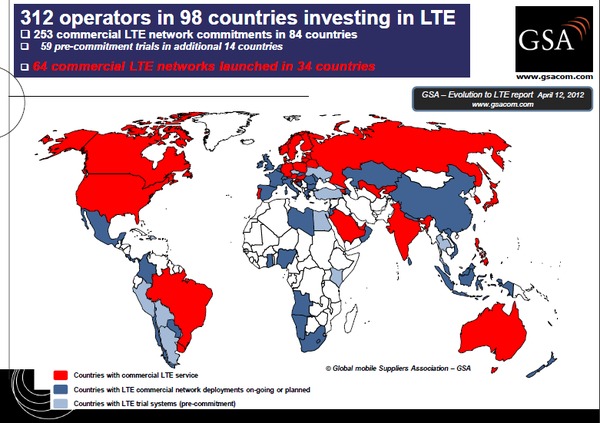
As you can see from the map above, 4G LTE is certainly the network of the future. With the much faster speeds, higher efficiency, and increased reliability, it is the next logical step in network technology development. There are some key points to note about the map though, which shows that LTE coverage isn’t as “colorful” as it seems:
- While a lot of countries are marked “red” indicating countries with commercial LTE services, it is slightly misleading. For example, while India as a whole is marked, only one carrier(Airtel) offers 4G LTE services in only one city(Kolkata) thus far. Of course, plans are in the works to rollout the network eventually, it will take quite a lot of time before complete coverage is achieved.
- The above point is true for most countries, with none boasting a full coverage LTE network. Full coverage in some regions will be achieved at the earliest by late-2013 to early-2014, with most others much later.
On the other hand, HSPA+ is more along the lines of a software enhancement that elevates 3G data network performance. Of course, the process isn’t as simple as it sounds, but it is definitely easier than building a completely new LTE supported network. As such, any carrier that has an established 3G network, have upgraded to an HSPA+ network. With over 100 network carriers worldwide featuring HSPA+ networks with most boasting over 80% coverage. To keep up with current LTE speeds, carrier networks are also upgrading the their “slower” 21Mbps networks to 42Mbps or even 84Mbps (theoretical) download speeds.
Cost
As mentioned earlier, the biggest issue with taking advantage of the faster speeds of a 4G LTE network is coverage. Availability is still quite limited but that will of course, get better. What surprised me is the lack of a difference in cost between a carrier’s HSPA+ and LTE networks.
- AT&T and Verizon have standard data rates of $50 for 5GB regardless of whether you have access to 3G, HSPA+, or 4G LTE networks.
- T-Mobile, which currently features a 42Mbps HSPA+ networks, also features the same data rates.
- In India, while available only in Kolkata so far, 4G LTE costs Rs 1399(~$28) for 9GB, with HSPA+ being Rs 1250(~$25) for 10GB.
Of course, I’ve only used the information from two places I’m most familiar with, so there might be other networks worldwide where there is a more evident price difference (or not), so if there are, do let us know in the comments section.
Device availability
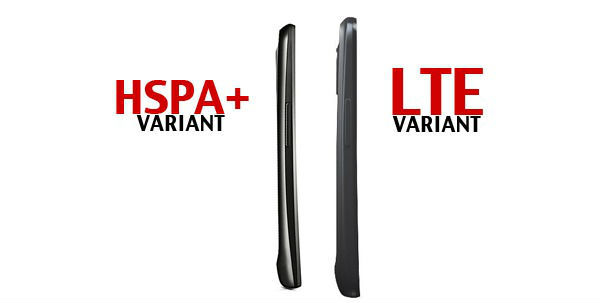
Device availability is another area where I consider LTE to be at a disadvantage. Here’s why:
- Most smartphones and tablets (3G versions) released in the last 2 years or so can access the faster speeds offered by HSPA+ networks.
- On the other hand, accessing a LTE network requires a significant hardware change, i.e. the need for an LTE radio.
- Options for LTE capable devices are comparatively limited and generally range towards the higher end of the price spectrum.
- There has been an incompatibility issue with latest NVIDIA quad-core Tegra 3 processor and LTE radios, as seen with the HTCOne X where the international version features the quad-core processor, and the US releases with LTE radios “falling back” on Qualcomm dual-core Snapdragon S4 processors. Whether this issue will be prevalent in other quad-core processors such as the Samsung Exynos 4412, is yet to be seen.
- LTE radios are also infamous for being a huge drain on battery life.
The Future
HSPA+
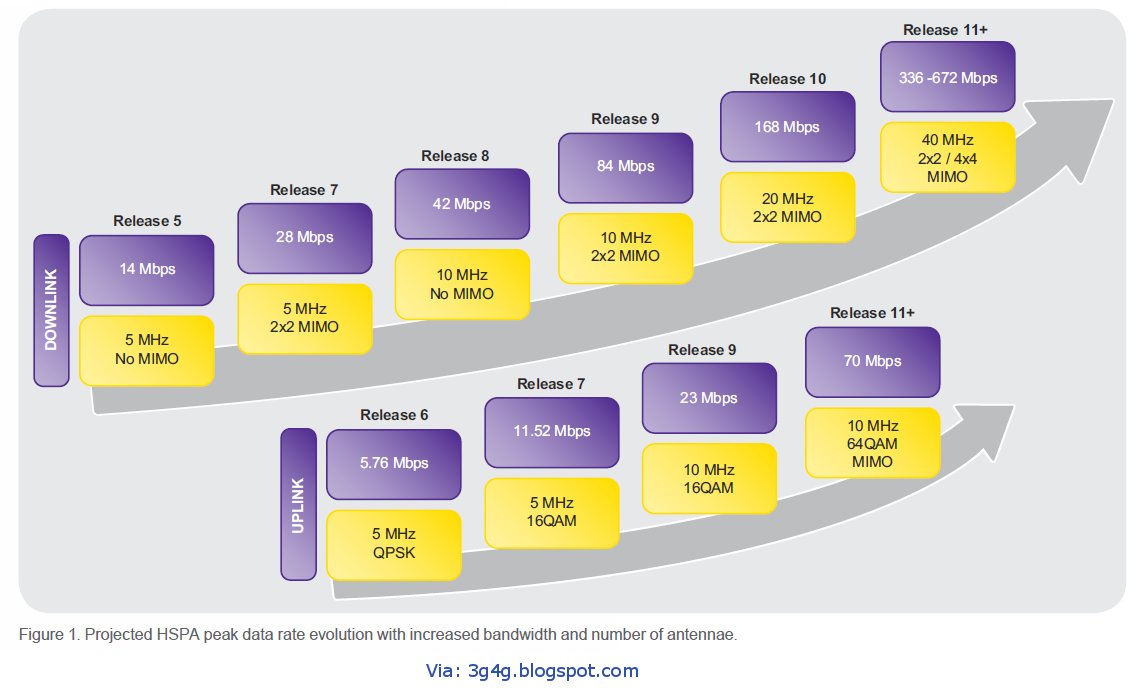
HSPA+, with its theoretical 168Mbps downlink speeds, still wasn’t the pinnacle of HSPA technology. Back in 2010 began talk of LTHE or Long Term HSPA Evolution. LTHE brought with a lot of advantages including:
- Backward compatibility with existing WCDMA and HSPA networks. This provided the possibility of an easy transition to LTHE as opposed to a network upgrade to LTE.
- Theoretical download speeds up to a whopping 672 Mbps.
- Carriers and hardware companies claimed that LTHE could have been ready for deployment by 2013.
Unfortunately, almost every network around the world has decided to move onto LTE as their network for the future. HSPA+ networks will likely be upgraded to the 42Mbps or even 84Mbps download capability, but now, it seems like that is as far as this evolutionary technology will be pushed.
LTE
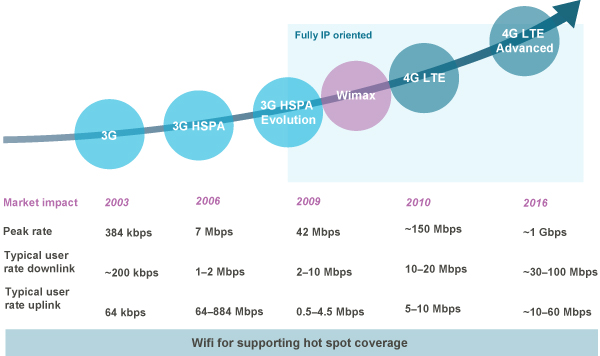
While HSPA+ was the peak of 3G technology, the current variation of 4G LTE is only the first step in this next stage, opening up numerous possibilities for much further advancement in this field. It is somewhat strange that advances in LTE technology are already being spoken about when the “original” standard networks aren’t even close to being fully established. Yet, that is the rapid speed in which the tech world progresses. Let’s take a look at some of these developments:
- TD-LTE: TD-LTE or Time-Division LTE was developed by China Mobile over the last few years. Unlike LTE networks which carries two separate signals for data traveling in either direction, TD-LTE features a single channel and allocated upload and download bandwidth depending on your usage. This accounts for higher data speeds. TD-LTE is also compatible 4G WiMax and it will easier to upgrade from WiMax to TD-LTE than to LTE.
- LTE Advanced: LTE Advanced is a further evolution of current LTE networks which brings with it theoretical peaks of 1GBps download speeds, increased spectrum efficiency(upto 3 times more bandwidth), and reduced latency. Like the upgrade from HSPA to HSPA+, a move from LTE to LTE-Advanced is also a software deployment upgrade.
- TD-LTE will also see a shift to TD-LTE advanced in the future.
Conclusion
Advantages of LTE over HSPA+
- The most obvious advantage is the higher data speeds
- Much better spectrum efficiency
- Far lower latency
- LTE has a simpler architecture compared to an HSPA+ network
Advantages of HSPA+ over LTE
- HSPA+ is an already established network, whereas complete LTE coverage still has a while to go
- HSPA to HSPA+ evolution required much less investment in infrastructure and was less costly to upgrade as opposed to LTE which needs a completely new network built from the ground up.
- LTE requires specific LTE radio featured devices, whereas HSPA+ is available to any user with a 3G enabled phone.
As you can see, LTE is definitely the way of the future, and the potential with this technology is incredible. But I still think there are a lot of factors that lead me to conclude that HSPA+ networks are certainly more than enough for now.
What are your thoughts? Is HSPA+ good enough for now? Is LTE not here fast enough? Let us know in the comments section below. We’d love to know what you think!